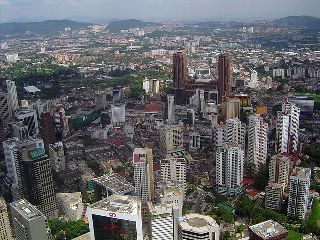 As the world’s economic activity continues to move at a moderate pace, Malaysia kept pace with a more modest expansion of 5.6% in the third quarter of 2014 against 6.5% in the second quarter of this year, according to an official release by Bank Negara Malaysia.
As the world’s economic activity continues to move at a moderate pace, Malaysia kept pace with a more modest expansion of 5.6% in the third quarter of 2014 against 6.5% in the second quarter of this year, according to an official release by Bank Negara Malaysia.
The global economy continued to expand at a moderate pace in the third quarter of 2014, with uneven growth performances across economies, the central bank noted. While the U.S. economy continued to show broader signs of improvements, growth in the euro area remained subdued amid persistent structural constraints and weakening sentiments. In Asia, economic activity continued to expand, although growth was more moderate in several economies.
The Southeast Asian nation’s growth was supported mainly by private sector demand and continued growth in net exports of goods and services.
Private consumption registered a growth of 6.7% in the third quarter vs. 6.5% in the second quarter, supported by stable labor market conditions and continued wage growth. Private investment fell to 6.8% compared to a growth rate of 12.1% in the previous quarter, as spending on machinery and equipment, particularly in the transportation segment, decelerated.
Public consumption turned positive to 5.3% from the second quarter’s decline of 0.5%, reflecting higher government spending on supplies and services. Public investment, however, declined further by 8.9% from a 3.3% slide the preceding quarter, traced mainly to the near completion of a few projects by public enterprises and the continued contraction in the federal government’s development expenditure.
“Going forward, investment activity will be supported by continued flow of ongoing and new projects by the private and public sectors,” said the financial authority.
On the supply side, all economic sectors in the third quarter all posted growth. The services sector managed to sustain its growth mainly on the performance of the consumption- and production-related services subsectors.
Growth in the construction sector was sustained by the residential and non-residential sub-sectors. After a strong performance in the second quarter, the manufacturing sector expanded at a more moderate pace amid slower domestic-oriented activity. The agriculture sector registered a slower growth following weaker output of palm oil and rubber, while the mining sector grew at a more moderate pace amid lower production of natural gas and condensates.
The country’s trade surplus narrowed to RM16.8 billion (US$5.03 billion) from RM18.5 billion in the second quarter. Gross exports grew at a slower pace of 1.5% from 14.4% quarter-on-quarter, arising from a higher base in the third quarter of 2013. Gross imports also moderated, registering a growth of 2.6% in the third quarter from 8.5% in the second quarter.
The central bank forecasts global growth to remain moderate and growth across the advanced economies to remain uneven. In Asia, economic activity will be underpinned by a continued expansion in domestic demand and exports.
“Nevertheless, there remains a considerable downside risk to global growth. These include prolonged weakness in domestic demand and low inflation in a number of major economies, uncertainty over monetary policy adjustments in the key advanced economies and persistent geopolitical tensions that could heighten financial market volatility,” said the bank.
Noting that while risks to growth have increased, “the Malaysian economy is expected to remain on a steady growth path,” it predicts further. “Although exports will benefit from the recovery in the advanced economies and from regional demand, the trend is likely to moderate reflecting both the high base effect from 2013 and lower commodity prices. While private consumption may moderate, investment activity will be supported by continued flow of ongoing and new projects by the private and public sectors. Going forward, domestic demand will remain the key driver of growth.”
Photo: Hintha




